The AMD Radeon R9 290X Review
by Ryan Smith on October 24, 2013 12:01 AM EST- Posted in
- GPUs
- AMD
- Radeon
- Hawaii
- Radeon 200
Company of Heroes 2
Our second benchmark in our benchmark suite is Relic Games’ Company of Heroes 2, the developer’s World War II Eastern Front themed RTS. For Company of Heroes 2 Relic was kind enough to put together a very strenuous built-in benchmark that was captured from one of the most demanding, snow-bound maps in the game, giving us a great look at CoH2’s performance at its worst. Consequently if a card can do well here then it should have no trouble throughout the rest of the game.
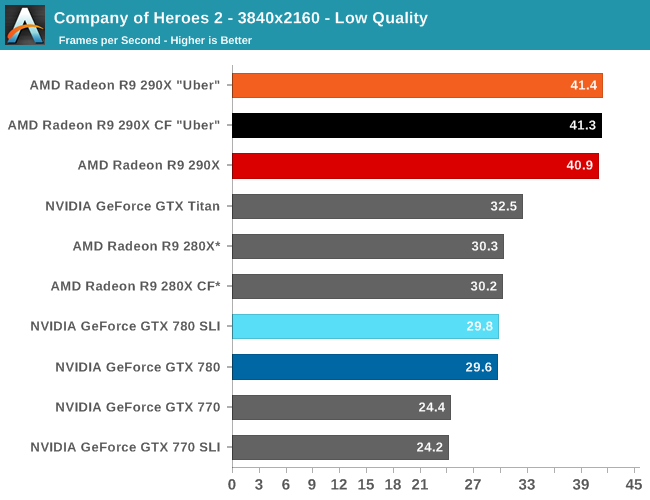
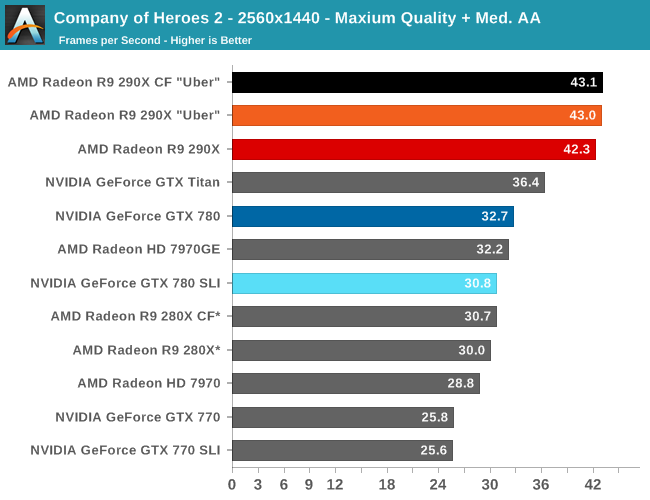
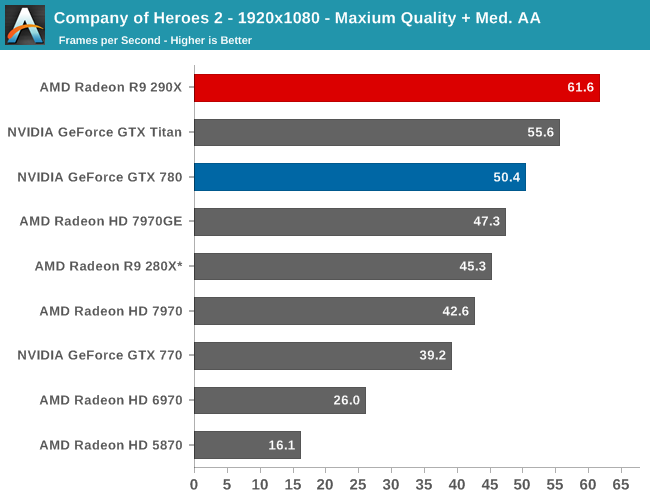
Our first strategy game is also our first game that is flat out AFR incompatible, and as a result the only way to get the best performance out of Company of Heroes 2 is with the fastest single-GPU card available. To that end this is a very clear victory for the 290X, and in fact will be the largest lead for the 290X of all of our benchmarks. At 2560 it’s a full 29% faster than the GTX 780, which all but puts the 290X in a class of its own. This game also shows some of the greatest gains for the 290X over the 280X, with the 290X surpassing its Tahti based predecessor by an equally chart topping 41%. It’s not clear what it is at this time that Company of Heroes 2 loves about 290X in particular, but as far as this game is concerned AMD has put together an architecture that maps well to the game’s needs.
Briefly, because of a lack of AFR compatibility 4K is only barely attainable with any kind of GPU setup. In fact we’re only throwing in the scale-less SLI/CF numbers to showcase that fact. We had to dial down our quality settings to Low on CoH2 in order to get a framerate above 30fps; even though we can be more liberal about playable framerates on strategy games, there still needs to be a cutoff for average framerates around that point. As a result 280X, GTX Titan, and 290X are the only cards to make that cutoff, with 290X being the clear winner. But the loss in quality to make 4K achievable is hardly worth the cost.
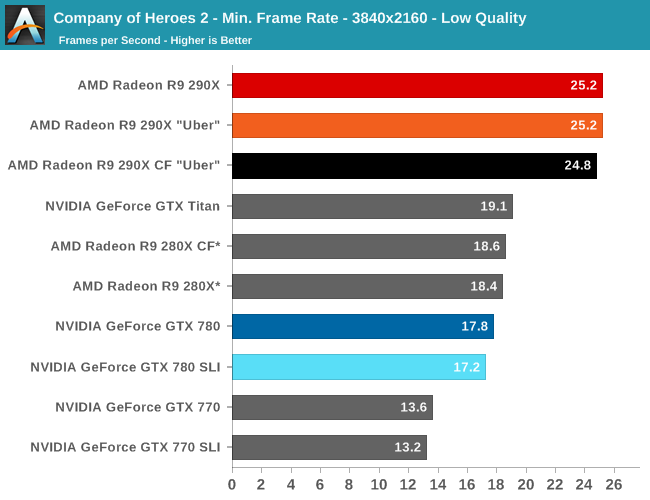
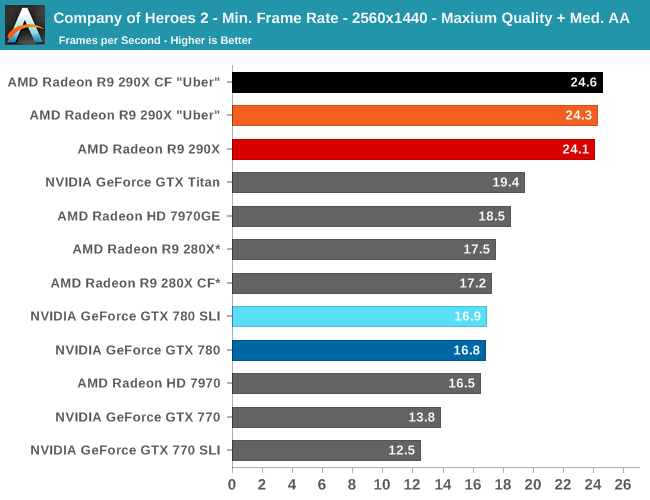

Moving on to minimum framerates, we see that at its most stressful points that nothing, not even 290X, can keep its minimums above 30fps. For a strategy game this is bearable, but we certainly wouldn’t mind more performance. AMD will be pleased though, as their performance advantage over the GTX 780 is only further extended here; a 29% average performance advantage becomes a 43% minimum performance advantage at 2560.
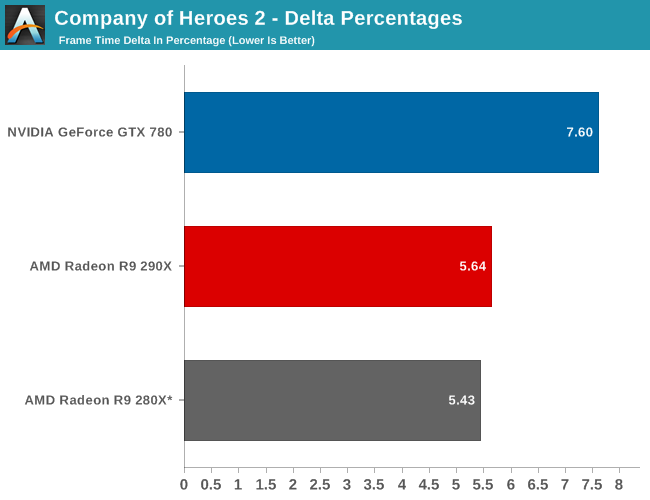
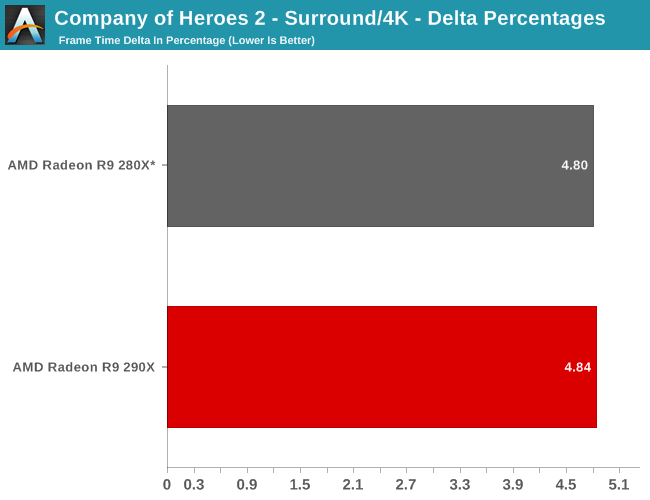
Finally, while we don’t see any performance advantages from AFR on this game we did run our FCAT benchmarks anyhow to quickly capture the delta percentages. Company of Heroes 2 has a higher than average variance even among single cards, which results in deltas being above 5%. The difference between 5% and 7% is not going to be too significant in practice here, but along with AMD’s performance advantage they do have slightly more consistent frame times than the GTX 780. Though in both the case of the 280X and the 290X we’re looking at what are essentially the same deltas, so while the 290X improves on framerates versus the 280X, it doesn’t bring with it any improvements in frame time consistency.










396 Comments
View All Comments
Da W - Thursday, October 24, 2013 - link
The reference cooler is noisy as hell, but it's a blower. At least it doesn't dump all the heat inside your case and let your other case fans handle it. It depends what you're looking for.Still make as much noise as the 5870 did, and it was a commercial success.
slickr - Thursday, October 24, 2013 - link
Didn't think AMD will deliver, in fact I thought from seeing some initial benchmarks that AMD took over 6 months just to deliver a graphic card slower than Titan and that even with a cheap price it wouldn't be enough, boy was I wrong.This card beats Titan in so many games and in so many resolutions and is almost $500 cheaper, its also $100 cheaper than the GTX 780 and anywhere from 5% to 20% faster than the 780, that is just amazing.
Hopefully this trickles down to the medium range cards and we are going to see cards like the 280x go for less than $250.
I mean unless Nvidia positiones the Titan at $550 as well, then I don't think it will sell very much at all. In the 290x you have a better performing card at almost half the price, Nvidia has its work cut out for them and I sure hope the 780 TI edition really brings in the performance and price as well.
eanazag - Thursday, October 24, 2013 - link
I'm sporting a Nvidia GPU in my rig. I don't see any option for Nvidia than to reduce both the Titan, 770, and 780 in cost. I can't expect the 780 Ti performance to trump the Titan. I will say that there is power and cooling room for Nvidia to ratchet things up and make this interesting. This is bold move on AMDs part and does wonders for consumers. Based on some of the other comments current news does not kill off either brand by the way. PC gaming and desktops are not dead.....kwrzesien - Thursday, October 24, 2013 - link
Ryan, can we get a pipeline article or retweet this article when it is complete? Thanks!spiked_mistborn - Thursday, October 24, 2013 - link
Nice job AMD! Competition is good! Also, feel free to use my GSYNC idea about putting a frame buffer in the display and letting the video card control the refresh rate. This post is from March 2013. Apparently adding a dash to make it G-Sync makes it different somehow. http://techreport.com/discussion/24553/inside-the-...Sorodsam - Thursday, October 24, 2013 - link
I'm surprised no one's commented on the new "AMD Center", or this troubling text:"You've landed on the AMD Portal on AnandTech. This section is sponsored by AMD."
There's a big difference between a site that runs an occasional AMD ad and a site with an entire section that's expressively "sponsored by AMD", especially considering AnandTech's (former?) guiding principle that product reviewers shouldn't be aware of who exactly is buying advertising and when. They can hardly be unaware of it now.
MrMaestro - Thursday, October 24, 2013 - link
The reason people aren't commenting on it is because it's already been commented on. Take a look at the article announcing AMD Centre. That is the appropriate place for such comments.anevmann - Thursday, October 24, 2013 - link
Ryan, will this card require PCIe 3.0 for gaming?Can you do a test with and without PCIe 3.0? I really want this card, but I wanna know in advance if I have to upgrade my system.
A
Ryan Smith - Monday, October 28, 2013 - link
I can't promise when it will be done (given the insanity of our schedule over the next 3 weeks), but at some point we will follow this up with a reprise article, that among other things will cover PCIe bandwidth vs. Crossfire scaling, CF testing in quiet mode, and some noise equalization to see what fan levels it would take to match a GTX 780 and what the resulting performance would look like.Anyhow, for a single card setup none of my data thus far supports PCIe 3.0 being a requirement. We're not to the point yet where PCIe 2.0 x16 is a general gaming bottleneck.
Hung_Low - Thursday, October 24, 2013 - link
Is 290X really the absolute maxed out version Tahiti? Or did it also leave a lot of room like Titan is for GK110.Perhaps the GPUs used in 290x are those Tahiti's with imperfection, with the high quality Tahiti's saved for extreme edition 290x/290x+ ?